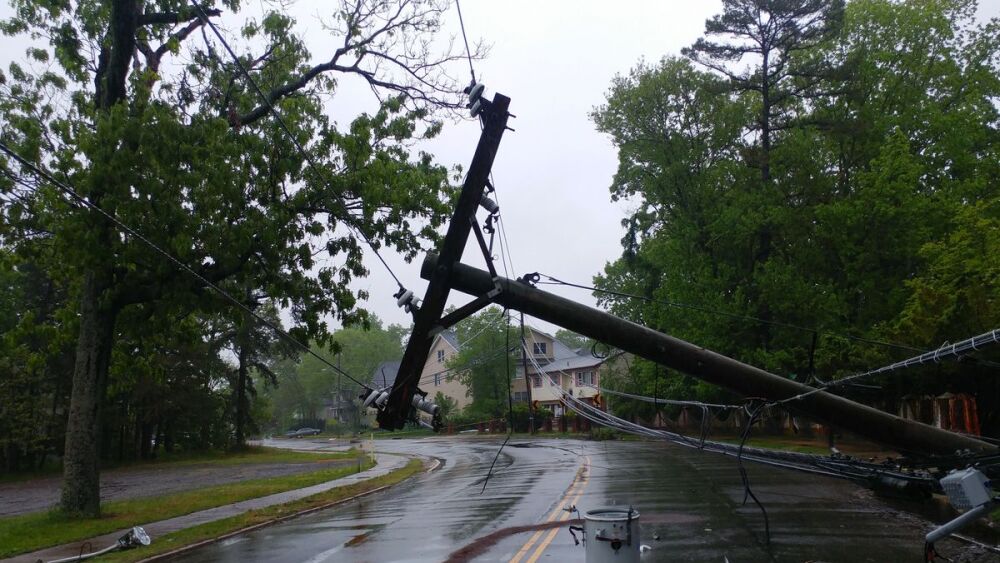Electricity is an unseen and often-misunderstood hazard for first responders. It’s present at almost every scene we respond to, and fortunately, it rarely affects our operations – but when it does, it can be devastating.
A recent news event, two incidents in my career, plus a review of near-miss reports from the National Firefighter Near-Miss Reporting system illustrate this reality.
Tragic event in Georgia
On July 13, first responders in Valdosta, Ga., were injured while working the scene of a downed power line during a thunderstorm. While blocking traffic, a truck entered the scene and struck the downed line. The truck dragged the line, resulting in the cable and a power pole breaking and striking responders. One firefighter’s injury was so significant that it required amputation of his leg.
This call transitoned from a routine lines down call to a serious trauma incident in the blink of an eye. How ready are we for responding to an emergency involving electrical utility infrastructure?
Understand the power
My fire department responded recently to a structure fire involving a downed power line – an incident that refreshed my awareness of electrical energy.
We were paged to a detached garage fire late at night. We arrived to find a garage fully involved, with flames starting to impact the house. Vehicles were burning in the garage, and as we completed a size-up and pulled a line to protect the home, the power line to the house began arcing and whipping around. It would periodically stop and start again, and ultimately created a hazard for crews trying to determine how to place the hoseline.
In our post-incident discussions, it became evident that there was a wide variety of knowledge regarding electrical hazards, plus varying degrees of concern about the seriousness of the power line. It’s always important to understand the level of risk so we can make the best decisions for our strategic and tactical goals. In this case, the power line was a definite threat to our safety.
Electricity basics
We all have different experiences throughout our careers, resulting in varying levels of awareness and knowledge. Using crew resource management techniques allows the company officer or incident commander to “crowdsource” a solution to the risk issue. For many risks or incident challenges we face, someone on the crew may have experiences or background in that subject and can help us understand what we are seeing. Knowledge from training or previous calls will provide this background.
But how much do we know about the systems that provide the energy we need in our everyday lives? These systems are safe and redundant, and we rarely encounter failures or hazards caused by them. This is good but also presents a problem: If we rarely see an electrical emergency or have never been formally trained on how our communities’ systems work, how can we be sure we correctly manage that risk?
A quick primer on how the electrical infrastructure in your community works is a logical place to start building awareness. Electrical energy is often discussed with a unit of measure called volts. A standard voltage for an outlet in your home would be 120 volts. This is a measure of the difference between the energized wire and the ground or negative wire. This is only half the story, however. The amount of energy present is measured in amps. Amps are the “punch” behind the voltage. An easy way to think of it in firefighter terms would be to compare it to a hoseline. Volts represent the diameter of the hoseline and amps are the pressure. We know a 2½-inch line can supply more water than a 1¾-inch hoseline at the same pressure. In addition, if we were to open the nozzle on a hoseline, the amount of pressure the line is pumped at determines how difficult it is to hold and how much impact it will have.
Several methods generate the power that lights and heats our homes. Coal-fired, nuclear, geothermal, solar or wind power are a few ways the electrical energy is initially generated. Once generated, it needs to travel to the customer, so it can be used to heat homes, turn on lights, run computers, etc. These transmission systems lines can be above or below ground. The voltage in the transmission lines is significantly higher than what we can use in our homes and business. This is due to the principle of electrical energy. It is more efficient to send power long distances at higher voltages. Remember the hoseline example: If we need to send lots of water a long distance, we would use a larger hoseline and pump it at adequate pressure. Transmission systems are no different.
Overhead transmission line voltages differ across various regions of the country and among individual utilities. These lines travel long distances from the source to a community, ending in a substation switchyard. These lines run on large steel towers and can have voltages over 200,000 volts. Once these lines reach your community, they enter a substation, where voltages are reduced and split up into various primary lines. These are the lines you see running along power lines in our response areas as well as underground. Voltages of these lines are much less than transmission voltages but still higher than what is utilized in our home and business. Primary voltages are often less than 15,000 volts, with 7,200 volts or 12,500 volts being standard. Finally, the power flows into a transformer, and voltage is brought down to the voltage we see, typically in the range of 120-240 volts, and occasionally 480 volts for industrial customers. Any of these voltages are capable of inflicting electrical burns, and higher voltages would be lethal.
Along the way, the utility uses numerous switches and breakers to manage flows and protect their system. Just like in your home, if a malfunction happens (like a tree branch or a squirrel in an unfortunate location), the breakers can trip and stop the flow of power. But unlike your home, the breakers are located in various locations around town – and they involve high voltages. For this reason, utility breakers will often make a few attempts to re-energize the line before locking in the open or off position. Bottom line: If you see a line on the ground, assume it is energized and hazardous, as a breaker may re-energize at any moment without warning.
Clear the area
When we encounter a line on the ground or work in proximity to a power line with an aerial device or ladder, it’s important to remember that the more voltage present, the farther we need to stay clear of the line to reduce the chance of an arc or spark from the wire to us. Remember, an aluminum ground ladder or a steel or aluminum aerial device is a great conductor of electricity, so keep your distance. A minimum clearance of 10 feet from primary lines will provide a minimum margin of safety, and 20 feet is even better. Increase this distance if you are operating near transmission lines.
Further, an energized line on the ground may not be sparking, but there may be voltage present in the ground as you approach the line. Staying clear of the line will prevent this problem.
A thermal imaging camera will allow you to easily visualize overhead lines at night, as they will appear warmer than the night sky. This can help you see hidden lines you may have otherwise missed.
Resource
How to buy thermal imaging cameras (eBook)
Download this FireRescue1 thermal imaging cameras buying guide to learn key steps for product selection, purchasing and implementation
The dangers of wires, cars and sparks
If you arrive at an incident involving a vehicle that struck a power pole, you could be faced with an energized line on a car. If possible, leave the line in place and wait for the utility company. The occupants of the vehicle will be safe if they remain in the vehicle. If they attempt to get out, when their foot touches the pavement, it cold provide a pathway for the electrical energy, and they will be shocked. The same could happen if a vehicle strikes a transformer on the ground or an electrical control box for streetlights, so always look under vehicles from a distance before approaching or touching them at an accident scene.
Another incident my agency responded to involved a crane that contacted an overhead transmission line. The voltages involved were much higher, and the consequences were more serious as well. Once the crane boom reached the line, it provided a path to the ground for the electrical energy. As the voltage and amperage were very high, the results were dramatic. Energy removed one wheel from the front of the vehicle, blowing off the tire, rim, hub and brakes, and all other tires on the truck were blown. The operator was standing adjacent to the crane, operating it from the ground. The force of the energy blew him back from the truck, and he sustained arc flash burns. He is fortunate, as he easily could have been killed.
A report submitted to the National Firefighter Near Miss Reporting System also illustrates this risk: “The engineer was performing a daily aerial ladder test on our department’s 100-foot aerial. The aerial ladder was extended toward some electrical power lines. As the engineer was rotating the ladder to stow it in the bed of the truck, the ladder became energized as it swung near the power lines. The tip of the ladder was approximately 25-30 feet from the power lines as it became energized. There was an audible sound of electricity as it charged the apparatus. Upon further investigation, there were dime sized char marks at the tip of the aerial. As the outriggers were stowed, we found charring and holes in the concrete beneath the outrigger pad from the electricity. No injuries were reported.”
Fires and smoke
If we respond to a structure fire and a downed line is present, communicate the hazard to other responders arriving on the scene and block off the area. Lines can be challenging to see in the dark. Make sure crews treat the line as energized even if it is not actively sparking. Lines have burned back into the exterior insulation and stopped sparking, even though they were still live and presented a hazard.
Additionally, fire smoke from a wildland fire can provide a pathway of energized particles that can cause a transmission line to arc to the ground. For this reason, keep crews out from under large transmission lines if a thick smoke column impacts them. In addition, a utility may de-energize transmission line sections to prevent this problem, although this is not always able to be done.
Voltage detection
Various devices allow firefighters to detect hazardous voltages without touching a wire or vehicle. These units measure the frequency of normal electrical energy. They often have a mode to determine what direction the unit is detecting the voltage, allowing you to determine whether an individual wire or line is energized.
Remember, though, even if a line does not show voltage, it can re-energize at any time, so it still may not be safe to assume you can work around or contact the line. Like other metering equipment, these detectors require initial and ongoing training and practice to safely use and interpret what they will tell you on a scene.
Don’t get complacent
Many responders will go through an entire career without encountering electrical emergencies – but we cannot become complacent, as electricity is present at most, if not all, incidents. We must periodically review and discuss the hazards electricity can pose, so we are ready for these highly dangerous hazards.




